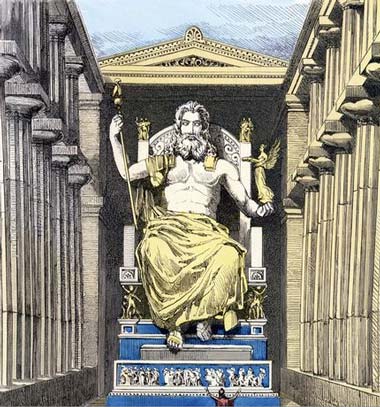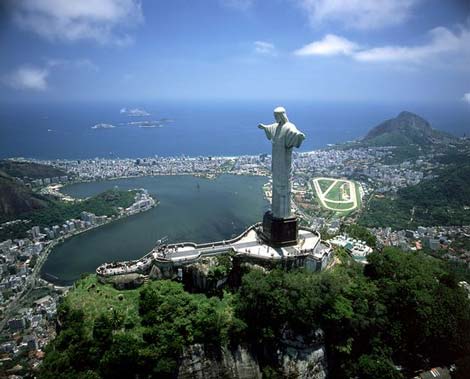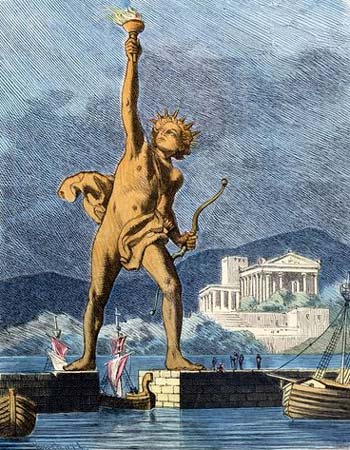Although all comparisons are lame, let's look and compare the beauty of the seven ancient wonders of the world (BC) with the seven wonders of the new world (SCN).

Old: Statue of Zeus in Olympia (Greece)
The statue was built in 470-460 BC, 12m high, nearly 7m wide, sculpted with the god Zeus sitting on the throne, with ivory skin, beard, hair, gown made of gold. The left hand holds the statue of Victory with a wing symbol for victory in the Olympics, the right hand holds the scepter adorned with a metallic eagle, symbolizing the supreme power of the king in the gods. Godhead Zeus wears olive wreath. The throne is made of cedar wood and ivory. The god foot rests on a large chair.

New: Jesus Christ in Rio de Janeiro (Brazil)
The statue of Jesus stands on a mountain of 710m high. The statue was erected in 1931, on the occasion of the 100th anniversary of Brazil's independence. 30m high statue standing on 7m platform. The head is 35.6 tons, 3.7m high. Each arm weighs 9.1 tons; The distance between the fingertips of the left and right hands is 23m. Inaugurated on 12/10/1931 after 5 years of construction, the statue has become a symbol of the city and warm feelings of the Brazilian people.

Old: Statue of the sun god Colossus in Rhodes (Greece)
The statue of the Sun in Rhodes is a giant bronze statue about 33 meters high, representing the sun god Helios - the protector god of Rhodes - that helped the city escape the siege of Demetrius - the king of Syria in 305 BC . According to many theories, the statue is located in the city of Rhodes, the capital of the Greek island of Rhodes. The statue was built in 280 BC and collapsed in an earthquake in 224 BC.

New: Great Wall (China)
The Great Wall stretches 6,352 km in Chinese territory, built with soil and rock from the 5th century BC until the 16th century, to protect this country from attacks by Mongols and Turks. , and other nomadic tribes from the regions of Mongolia and Manchuria. The most famous of which is the walls of the first Emperor of China, Qin Shihuang, ordered to build from 220 BC and 200 BC, located farther north than the current Great Wall of China. in the Ming Dynasty, and only a few remains remain.

Old: Giza Pyramid (Egypt)
The tomb of Giza, built around the 26th century BC, is a whole of 3 pyramids with the highest pyramid height of 145.75 m. Cheops Pyramid in the Giza pyramid complex, built by a Pharaoh (Khufu) for his grave, mobilized more than 100,000 workers in 30 years, using more than 230,000 stones (each plate). weighs 6 tons. King Chephren's pyramid lies behind Khufu's pyramid and in front of Mycerinus's pyramid. Three smaller pyramids in front were built for the three wives of King Mycerinus.

New: Colosseum Arena (Italy)
It was a large arena with a capacity of 50,000 spectators, built around 70 and 72 AD under the Vespasian emperor and completed 80 AD under Titus. The arena is used for athletes to compete and perform in public.
Colosseum arena was used for nearly 500 years, in addition to the purpose of making a ring, this place is also used for public performances, fake drills. Although now largely abandoned by earthquakes and rock robberies, the Colosseum has long been considered the symbol of the Roman Empire and one of the most beautiful samples of Roman architecture left over.

Old: Mausoleum Tomb (Turkey)
The tomb was built by Queen Artemisia II for her husband, King Mausolus of Caria, in Asia Minor, from 353 BC to 351 BC. The tomb was built in the city of Halicarnassus, the capital of Caria, employing 1200 workers, working hard for 17 years. By 1494, a group of knights in the Crusade used marble blocks of the tomb base to build a castle. Most of the blocks here are cut into small pieces to build the castle. Today this castle still exists with pieces of marble separated from the tomb of King Mausolus.

New: Taj Mahal Temple (India)
Emperor Mogon Shah Jahan (of Persian origin, who was crowned in 1627) ordered it to be built for his beloved wife Mumtaz Mahal. The temple was built in 1632 and completed in 1648. After completion, the king ordered the hands of the masons to be cut so they could never build such a beautiful temple. this too. Taj Mahal is a collection of elements of Persian, Turkish, Indian and Muslim architectural styles. The white marble dome is considered the most outstanding part. Taj Mahal was recognized by UNESCO in 1983.

Old: Temple of Artemis (Turkey)
Artemis hunting temple, also known as Diana temple, is constructed of 115m long, 55m wide marble, consisting of 127 stone columns, in Ephesus city. The temple was built in 550 BC, undergoing reconstruction and expansion over many periods, the last being 430 BC. In 356 BC, the temple was destroyed by fire on the night Alexander the Great was born. A similar temple was rebuilt on the old temple background. In 262, the Goths burned the temple for the second time. Only the background and some other parts of the second temple still exist today. The British Museum in London also stores some relics of the second temple.

New: Petra relic (Jordan)
Located on the slopes of Hor Mountain, Petra is famous for having many statues carved on the cliffs. This relic was introduced in 1812 by adventurer Johann Ludwig Burckhardt and recognized by UNESCO in 1985. It is described as "one of mankind's most precious cultural assets".

Old: Alexandra Lighthouse (Egypt)
The lighthouse was built under King Ptolemy I, inaugurated around 2001 BC under King Ptolemy II and completely collapsed in 1303 in a terrible earthquake. Except for the Pyramid at Giza, the lighthouse is the tallest building in the ancient world. The lighthouse is located right at the entrance to Alexandria harbor, consisting of 3 floors, about 135m high. Bottom of the square, including many rooms for permanent lighthouse guards, cattle and food.

New: Chichén Itzá ruins (Mexico)
Chichen Itza is a Mayan civilized archaeological site, located in the northern part of the Yucatán Peninsula, Mexico today. Considered an important imprint of Maya Toltec civilization, the Chichen Itza relic site has typical architectural works of Central America, a harmonious combination of Maya construction techniques and station carving decoration. fussily.

Old: Hanging Gardens of Babylon (Iraq)
Babylon Hanging Gardens (also known as Semiramis Hanging Gardens) is a building built by King Nebuchadrezzar II in 603 BC to relieve the memory of his wife's Medes homeland Amyitis. There is a system in the hanging garden. The fountain consists of two large wheels linked together by chains with wooden crates. When the wheel rotates, the chain and the water tank also move the water in a tank upwards to water the plants. To water the flowers and plants of the garden, the slaves have to take turns taking water from the Euphrates river to the garden.

New: Machu Picchu Fortress (Peru)
Machu Picca, also known as the " Lost City of the Incas ", is an Inca ruins of pre-Columbo in a well-preserved state at an altitude of 2,430 m on a pointed mountain. Being forgotten by the outside world for centuries, although the locals still know it, Machu Picchu has returned and attracted the attention of the world by the work of archaeologist Hiram Bingham - who has re-examined This place was destroyed in 1911. In 1983 this place became a World Heritage Site by UNESCO.














 'Fine laughs' - Scary and painful torture in ancient times
'Fine laughs' - Scary and painful torture in ancient times The sequence of numbers 142857 of the Egyptian pyramids is known as the strangest number in the world - Why?
The sequence of numbers 142857 of the Egyptian pyramids is known as the strangest number in the world - Why? Miracle behind the world's largest stone Buddha statue
Miracle behind the world's largest stone Buddha statue What is alum?
What is alum?